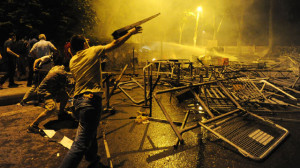
Αυτό που εκπλήσσει στην κατάληψη του Gezi και στις μαζικές συγκεντρώσεις στην πλατεία Taskim είναι η απόλυτη απουσία των μεγάλων συνελεύσεων, των ανοιχτών συζητήσεων, όλων των μορφών συλλογικής λήψης αποφάσεων που κυριάρχησαν σε άλλα λαϊκά κινήματα τα τελευταία χρόνια. Εδώ, η αυθόρμητη οργάνωση είναι πλήρης, χωρίς κανείς να έχει πραγματικά ιδέα για το τι συμβαίνει συνολικά, καθιστώντας αδύνατο τον έλεγχο της κατάστασης, ή τον εκδημοκρατισμό των αποφάσεων με επίσημες διαδικασίες και έμπειρους ειδικούς των διαδικασιών αυτών. Εκατοντάδες μικρο-ομάδων και χιλιάδες άτομα προσφέρονται εθελοντικά για να φέρουν φαγητό, να κάνουν ιατρικό έργο, να καθαρίσουν το χώρο, να κάνουν περιπολίες στα οδοφράγματα, να διανείμουν νερό, αλλά όλα αυτά δεν οργανώνονται ή συντονίζονται κεντρικά. Υποτίθεται ότι υπάρχουν διαπραγματεύσεις σε εξέλιξη μεταξύ κάποιων ομάδων από την κατάληψη και την κυβέρνηση, αλλά το να αποκαλούνται αυτές οι ομάδες «εκπρόσωποι» του κινήματος είναι γελοίο, και οι συμμετέχοντες σ’αυτές το ξέρουν, γι’αυτό και δεν διεκδικούν να μιλήσουν στο όνομα όλων αυτών που βρίσκονται στο Gezi και την Ταξίμ. Η κυβέρνηση θέλει να φύγουν τα οδοφράγματα, να καθαρίσει η πλατεία, και να ηρεμήσει το πάρκο. Οι αρχικοί διοργανωτές της κατάληψης του πάρκου δεν θέλουν την καταστροφή του πάρκου, ζητούν να μη γίνει κανένα έργο mega-ανάπτυξης, και απαιτούν την υποχώρηση της κυβέρνησης. Αλλά τι θέλουν οι δεκάδες χιλιάδες σε όλη τη χώρα; Τι θέλουν οι εκατοντάδες χιλιάδες, ίσως και εκατομμύρια που συρρέουν στην Κωνσταντινούπολη καθημερινά; Κάτι περισσότερο από μια μεταρρύθμιση, κάτι λιγότερο από μια επανάσταση, κάτι στο ενδιάμεσο που δεν ξέρουμε ακόμη πώς να το ονομάσουμε.
Ολόκληρη η “αναφορά” (στα αγγλικά):
“Everyday I’m Çapuling!” reads the banners all over Gezi Parkl, having become the unofficial slogan of the uprising. Çapulcu is what Prime Minister Erdogan called the demonstrators, meaning ‘looters’, hooligans, slackers. Accepting the challenge, the people have embraced the word, adding it to signs, shirts, graffiti, barricades, masks, buses. Everyone tells us how funny the slogans are; one barricade is spray painted with “Look how beautiful this barricade is.” Erdogan recently suggested that all women should have at least three children to support the great Turkish nation. So one of the chants blasted during the rally responded with: Do you want three children like us? The humor catches everyone off guard, especially the government, who have amped up the repression in Ankara, Izmir and other poor parts of Istanbul. But the mocking, jokes, and satire doesn’t stop, creating a complex language of resistance mixed with self-reflection that elevates the critiques to a whole new level of vitriol.
Saturday was the day of the football hooligans, where one hundred thousand of Istanbul’s ultras united to take part in the mega-rally at Taksim, screaming anti-government chants at the top of their lungs mixed with each team’s call-and-response. “Drop your sticks, throw away the gas, come and get us!” everyone shouted at one point. “Blue” “Yellow” Blue” “Yellow” could be heard for miles as crowds bounced up and down waving team flags and pointing firecrackers in the sky. Every inch was packed and noone could move anywhere but together. The bitter enemies of Fenerbahce and Beşiktaş did the impossible and joined together to shoot off fireworks and drape banners over the towering AKM building surrounding the square, as another hundred thousand people looked on and celebrated their previously unthinkable peaceful co-existence. Not only the uniting of the football fans but the sheer heterogeneity of political groups sitting together has been the most shocking of all. Weeks ago it was unthinkable for nationalists and kurdish groups to share space in a rally, let alone the scores of leftist sects that hate each other, but now its already normal. Not everyone gets along, but everyone has a corner, and everyone has the freedom to give and take as they please.
What’s stunning about the sprawling occupation of Gezi park and the mass demonstrations in Taskim square is the utter absence of large assemblies, consensus trainings, and open meetings, all forms of collective decision making which dominated other popular movements in the last years. Here, the spontaneous organization is complete, without anyone really having a clue of what’s going on overall, making it impossible to control, diffuse, or democratize with formal procedures and skilled experts. Hundreds of micro-groups and thousands of individuals volunteer to bring food, do medical work, sweep the grounds, patrol the barricades, distribute water, but it is in no way centralized or coordinated. Supposedly there are negotiations going on with some groups and the government, but to call those groups “representative” of the movement is laughable, and they know it, claiming not to speak for anyone at all. The government want the barricades gone, the square cleared, and the park tamed; the original organizers of the park occupation want no park destruction, no new mega-development, and a retreat of the government’s . But what do the tens of thousands across the country want? What do the hundreds of thousands, maybe millions in Istanbul who stream in and out everyday want? More than a reform, less than a revolution, something in between we don’t know how to name yet.
Sunday all the parties came out with their flags and speeches, but it was mostly a day for families, music, kids, and celebration. Down the main shopping streets rode bike gangs who rode in from all over Turkey to take part. Everywhere the same melodies could be heard: Tayyip Istifa! Tayyip Resign! Schoolchildren sit in smashed out buses posing for photos with their moms as trade-unionists form circles with environmentalists to dance to traditional music. The barricades are silent now, safety is assured, and all is well in this city on the hill. The calm has descended like a fog, everything seems like it will last forever, and that’s why everyone knows it won’t.

Pingback: 11.06.2013 Dienstag « Les Camarades Imaginaires